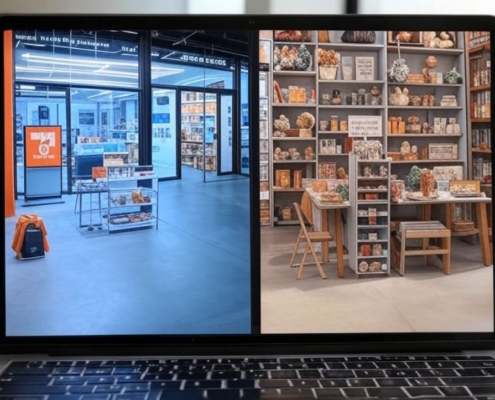Introduction
In the arts, realism typically refers to an endeavor to authentically depict the subject matter while eschewing fantastical and supernatural components. Though they are not identical, the phrase and naturalism are frequently used interchangeably. The concept of naturalism, which pertains to visual realistic depiction in Western artwork, aims to portray objects with minimal aberration and is associated with the advancement of illusionism and linear perspective during the Renaissance period in Europe.
Realism is a phrase used to describe a certain art historical trend that started in France during the years following the 1848 French Revolution, even though it is based on the realistic portrayal and deviates from the idealization of previous academic art. The resurgence of left-wing politics and a renewed curiosity in the average man drove realism, with painters such as Gustave Courbet making money from the banal, realistic, ugly, or vile. With its origins in late eighteenth-century French art and literature, Romanticism was rejected by realist painters.
By avoiding social and political issues and claiming the quasi-scientific foundation, the term “naturalist school” or “naturalism” was almost artificially created in nineteenth-century Europe to refer to an independent realism sub-movement that played on the popular understanding of “naturalist” to be a learner of natural historical events, just like the biological disciplines were then recognized.
Various artistic movements have invoked realism, including Italian neorealist movies, theatrical realism, literary realism, and the operatic verismo style.
Visual arts
In adjective form, “realistic” sets itself apart from “realist” artwork that deals with subject matter; it usually refers to how it looks. In the same way, the realistic representation of visual aspects within a composition may be referred to as “illusionistic”. The accurate portrayal of things and occurrences in art, with meticulous attention to detail, is known as naturalism in painting. Also known as mimesis or/and illusionism, it is most noticeable in European paintings during the Earliest Netherlandish period, which was created in the fifteenth century by artists such as Jan van Eyck and Robert Campin.
Gustave Courbet and other Realistic artists of the nineteenth century weren’t particularly known for their meticulous and accurate portrayals of visual looks; instead, academic painting, and these frequently portrayed imagined or highly manufactured scenes with extreme proficiency and care, was more prevalent at that point in time. Realism as a painting trend is defined by the subject matter chosen and treated, not by the meticulous attention to detail.
1. Resisting idealization
Realistic or naturalistic painting, which is characterized by an unidealized and honest, portrayal of the topic, can be applied to any kind of theme without having to present it as if it were ordinary. This also had classical cases, which helped to justify comparable approaches in the Baroque and Renaissance, despite the prevailing ideal of classical artwork.
Even politicians favored a realistic portrayal in portraiture during the time of the Roman Republic, whereas the early kings favored Greek idealism. BCE sculptor in the fourth century, Demetrius from Alopece was a sculptor whose art (all now gone) was reported to favor realism above ideal beauty. The drawings of the royals of Spain by Goya mark a kind of pinnacle in the realistic and blatantly unfavorable depictions of notable individuals.
“Realism” had been a recurring theme in Christian artwork, emphasizing the realistic side of sacred figures, particularly Christ and his bodily sufferings in the Passion. This emerged in the latter part of the Middle Ages, influenced by trends in sacred literature, and included some depicted wooden sculptures going so far as to depict Christ adorned with blood and wounds, hoping to provoke the audience to reflect on the agony that Christ had endured on behalf of humanity. Particularly, Germany & Central Europe were home to these. Such pieces resurfaced throughout the Baroque, particularly in Spanish sculpting, after slowing down during the Renaissance.
The proper balance between creating art from nature observation and pictured forms—usually those derived from traditional representations or the creations of other creators in general—was a topic of discussion initiated by Renaissance philosophers and continued for a number of centuries. While everyone agreed that the realistic world is important, many thought it must be followed to the point of only containing the beautiful.
One of the proponents of the unadulterated/realistic examination of nature, Leonardo Da Vinci aimed to capture the entire spectrum of distinct shapes found in humans and other objects. Among the early idealizers, Leon Battista Alberti emphasized the realistic. Michelangelo, on the other hand, supported picking out what was most exquisite; for this reason, he declined to create portraits.
The discussion carried over until the seventeenth century. The focus in Italy was typically on the difference between the Carracci’s “classical-idealism” and the Caravaggisti’s (Caravaggio’s followers) “realistic” style, which depicted scenes of religion as though they were in the hidden lanes of modern Italian towns and used the term to describe themselves. Writing several decades following Caravaggio’s untimely death and not being a fan of his aesthetic, Bellori makes reference to “People who exult in the title of naturalists”
Naturalism emerged as a generally defined genre in European artwork throughout the nineteenth century, despite the fact that realistic practitioners were inspired by different political ideologies. Antoine Castagnary, a French critic for the arts, stated in 1863, “The naturalist philosophy asserts that artistic expression is the ultimate goal of reproducing nature by bringing it to its fullest intensity and strength and that it represents the manifestation of existence in everyone of its manifestations and phases: It’s science and truth in balance.” This statement is credited with coining the term. Émile Zola used the phrase to convey his novel’s objectives while emphasizing it in an analogous scientific manner. Similar in subject matter to Impressionism, a large portion of realistic painting was done in landscapes with typically more melancholic weather and tighter, more conventional brushwork styles.
Over many years, the phrase “went on to be employed arbitrarily for different types of realism” frequently served as a generic term for work that was neither academic nor affiliated with any of the later Modernist groups, such as Impressionism.
The word “naturalist” is also frequently applied to movements such as the subsequent Düsseldorf School of Art and French Barbizon School, which attracted pupils from many nations, and the US Regionalism of the twentieth century. However, it is hardly ever used to refer to British art. By suggesting that the Impressionists or Courbet deserve the title, several contemporary art scholars have added to the uncertainty.
2. Illusionism
In the history of art, there has been a lengthy tradition of developing more realistic depictions of objects’ visual appearances. A few of its components are the realistic portrayal of both human and animal anatomy, perspective and the impact of distance, & the finely detailed impacts of color and light. Animal pictures in Upper Paleolithic European art were extraordinarily realistic, while Egyptian art established stylization & idealization rules that nevertheless made it possible to generate highly effective images in large quantities and with consistency.
It is widely acknowledged that Greek art advanced the depiction of anatomy, which has continued to be a significant model since then. Although many famous Greek painters’ original panels and wall paintings have vanished, it is evident from literary narratives and the body of surviving derived works—usually Graeco-Roman mosaic paintings—that it was prized in painting. Even though Pliny the Elder’s well-known account of birds nibbling at grapes drawn by Zeuxis around the fifth century BC is purely legendary, it does illustrate the goal of Greek art.
Roman paintings exhibit accurate light, color, and shape representation in addition to an unproven but effective understanding of perspective in expressing regular realistic geometric patterns like a room’s walls and roof, and how to make distant things appear smaller than nearby ones. Although some works, like the head sculptures of the infamously ugly Socrates, were permitted to slide below these highest standards of splendor, sculptures of Greek heroes and deities often attempt to accurately represent idealized & beautiful shapes. This advancement in illusionistic outcomes does not in any way imply an abandonment of idealism. When Roman portraiture isn’t overly influenced by Greek art, it demonstrates a stronger dedication to verism or accurate portrayals of its characters.
It is generally known that Late Antiquity artwork rejected illusionism in favor of expressive intensity; this shift had already started by the point that Christianity started to have an impact on aristocratic art. The introduction of new oil painting techniques, which allowed for the precise and subtle painting of light effects using tiny brushes and multiple layers of glaze and paint, was instrumental in helping the West achieve classical norms for illusionism again in the Early Renaissance and Late Mediaeval periods.
These developments occurred initially in Holland in the first half of the 15th century and in Italy around the 1470s. Early fifteenth-century Italians invented scientific techniques for depicting perspective, which subsequently extended throughout Europe. Under the tutelage of classical painting, precision in anatomy was also rediscovered. Idealism persisted as the standard, just like in classical times.
Using extremely subtle techniques to depict an assortment of weather patterns and levels of daylight, seventeenth-century Golden Age Dutch painting elevated the realistic representation of landscape to an extremely high standard. This development of landscape art also occurred in Early Northern Renaissance/Netherlandish and Renaissance painting in Italy.
Although the individuals were frequently idealized by flattening their features or adopting an unnatural attitude, European portraiture by 1600 was able to provide a very excellent likeness in sculpture as well as painting. The development of illusionistic painting was greatly aided by paintings of still life and the use of still-life aspects in different works.
However, in the Netherlandish custom of flower drawing, elaborate arrangements of bouquets in vessels, which were entirely unusual for seventeenth-century routines in which flowers were presented one at a given moment, were long lacking in “realism” because flowers from every season were usually used, either as a way of putting together compositions from distinct sketches or simply as an intentional convention. It’s interesting to note that, despite having pioneered the growth of illusionistic painting, the still-life genre was considered equally important in its renunciation within Cubism.
3. Illustration of common subjects
Although it was frequently confined to the periphery of compositions and displayed on smaller canvasses, the portrayal of common, daily, realistic subjects in artwork has an extended history. A minimal amount of time or effort could be allocated to such images due to the high cost of art, which was typically commissioned for religious, personal, or political purposes. Small events of realistic life can occasionally be found in the drolleries found in the outer margins of illuminated manuscripts (medieval).
Additionally, the creation of perspective generated large background fields in many parts that take place outdoors, which could be enhanced by the inclusion of small representations attending their daily lives. Even in holy or historical events set in the distant past, no alteration was necessary because the tradition of medieval and initial Renaissance painting was to depict non-sacred persons in modern clothing.
In the beginning stages of the Netherlandish painting movement, portraits were painted of wealthy merchants from Flanders, representing a social strata. Jan van Eyck’s 1434 Arnolfini Portrait is one example of this. More frequently, however, religious scenes, like the Merode Altarpiece done by Robert Campin in 1427 feature realistic representations of middle-class interior spaces filled with carefully chosen objects. But the reason these items exist at all is that they are laden with layers of nuanced meaning and metaphor that subvert any devotion to realism.
Cycles of the Labors of the Months, a major influence on the development of landscape painting as well as the portrayal of common workers, focuses on peasants performing various tasks throughout the seasons, frequently against a lush natural backdrop. Several instances of these cycles in contemporary medieval art have survived from literature of hours.
Large paintings showing realistic people at work, particularly in kitchens and food markets, were popular in the sixteenth century, and in several, the food was painted with equal importance to the people doing their jobs. Artists that worked in fundamentally Mannerist styles comprised Pieter Aertsen and Joachim Beuckelaer (his nephew) from the Netherlands, and during the 1580s, youngster Annibale Carracci from Italy who used a very simple, unpolished approach.
Bartolomeo Passerotti was in between both of these styles. Large panoramic images of rural life were first painted by Pieter Bruegel the Elder. These scenes served as an introduction to the widespread popularity of parts of work in the seventeenth century throughout Europe. Several categories of these scenes originated from Dutch Golden Age painting, including genre works of bodegones in Spain and Italy, the Bamboccianti (although mainly from the Low Nations), and the incorporation of unidealized farmers into historical works by Velázquez and Jusepe de Ribera.
Townspeople were seldom painted by the Le Nain brothers of France or by other Flemish painters such as David Teniers (Elder & Younger) and Adriaen Brouwer. Instead, they primarily depicted peasants. Little paintings depicting realistic individuals at work, primarily based on the Dutch style and highlighting ladies in particular, continued to be popular throughout the eighteenth century.
A lot of art, especially prints that showed everyday people was humorous and ethical, but it doesn’t seem like the moral lesson was often emphasized by the subjects’ extreme poverty. This began to alter in the middle of the nineteenth century, when emphasis was placed on the challenges faced by the impoverished. Painters generally tended to depict impoverished rural people, leaving illustrators like Gustave Doré to depict the awful conditions of urban slums, even though this trend coincided with massive migrations from rural areas to cities throughout most of Europe. Impressionists and similar artists often painted crowded streets of cities, particularly those depicting realistic Paris.
Technology illustrations were frequently commissioned from manuscript illuminators (medieval). Following the Renaissance, these realistic images persisted in book illustrations and designs, but until the beginning of the Industrial Revolution, they largely vanished from artwork, with the possible exception of marine paintings, which were created by a select few painters, including Joseph Wright from Derby & Philip James de Loutherbourg.
It is likely that these subjects did not sell effectively, and up to the latter part of the nineteenth century, when paintings started to get commissioned—usually on a big scale, but sometimes with quasi-heroic handling—by businessmen or for organizations in industrial cities—there is a conspicuous lack of manufacturing-related painting, apart from a few depictions of trains.
One of the numerous modern trends to apply realism in a similar way is American realism, which emerged at the beginning of the twentieth century.
4. Realist movement
In response to historical painting and romanticism, the Realist campaign/movement emerged in the middle of the nineteenth century. Realistic painters preferred to depict ‘real’ life; therefore, they chose to base their paintings on regular laborers and everyday people going about their daily lives in everyday environments. The main proponents of this style were Jean-François Millet, Jean-Baptiste-Camille Corot, Honoré Daumier, and Gustave Courbet.
As per Ross Finocchio, who was previously affiliated with the Metropolitan Museum of Art’s Dept of Paintings, Realists employed raw detail to portray the realistic everyday modern life, which aligned with the naturalist writings of Gustave Flaubert, Émile Zola, and Honoré de Balzac.
Several other Western nations have movements that developed considerably later than the Realist movement of France. Russian realists like Ilya Repin, Ivan Shishkin, and Vasily Perov were among the many members of the Wanderers, or Peredvizhniki group, which was influential in the country’s art and was founded in the 1860s and began organizing exhibits in 1871. Realistic painters who addressed social problems in Britain, like Luke Fildes and Hubert von Herkomer, had remarkable success.
Literature
In literary terms, realism is a movement founded on “objective reality,” broadly interpreted as “the true depiction of reality.” Without dramatization or romantic idealization, it concentrates on depicting ordinary activities and living, mostly within the middle-class and lower-class populations.
In the words of Kornelije Kvas, “Realistic re-figuration or figuration of existence create logical constructions that resemble our typical conception of reality while abiding by the principles of three different kinds of laws: social, psychological, and natural sciences laws.” It can be seen as an overall attempt to represent subjects “with compliance to secular, empirical rules,” without elaboration or comprehension, as they are believed to be present in 3rd-person reality. Therefore, the method presupposes that this truth is conceptually independent of humanity’s conceptual frameworks, language conventions, and beliefs.
As a result, it can be understood (or identifiable) by the creator, who can then accurately reflect such “reality” in their work. In the words of Ian Watt, “Contemporary realism starts with the idea that each person can use their senses to uncover the truth.” thus “originating with Descartes & Locke, Thomas Reid gave it its first comprehensive articulation in the mid-1800s.”
Realistic thinking was a response to Romanticism, even though the romantic period that preceded it was likewise an uprising against the ideals of the Industrial Revolution. For this explanation, realism is sometimes disparagingly alluded to as “bourgeois” or “traditional realism”. Realistic works were written by certain Victorian authors. Beginning about 1900, the main inspiration behind contemporary writing was the critique of the nineteenth-century wealthy social system and worldview, which was met with an antibourgeois, anti-rationalist, and antirealist program. The constraints, rules, and other restrictions of “bourgeois realism” in turn sparked a rebellion later dubbed modernism.
Theatre
It is believed that theatrical realism originated in European theatre around the 1800s, following the Industrial Revolution & the scientific era. A few have also pointed out that realistic theatre was founded on the introduction of photography, but some believe that the relationship between drama & realism dates back much further, as seen by the fundamentals of dramatic shapes, which include portraying the real world in a way that is true to life.
The goal of theatrical realism sought to draw awareness to the psychological and social issues that arise in daily life. People appear in its plays as victims of circumstances greater than themselves, as people facing a world that is speeding up quickly. The writers who pioneered this movement did not hesitate to portray their protagonists as common people who lack agency and are unable to find solutions to their problems.
The imagery in this kind of art reflects what the human eye sees. For example, Anton Chekov exposed the discursive and seductive nature of realistic theatricality by reproducing an uninflected piece of reality through camera work. Researchers like Thomas Postlewait observed that realistic and melodramatic functions and forms were frequently combined during the 19th and 20th centuries. This was evidenced by the way melodrama aspects were present in realistic shapes and conversely.
Theatre historians have determined that the first push towards realism occurred in the latter part of the 1870s and the beginning of the 1880s, which means that in the USA, realism in play predated fictitious realism by roughly two decades. Its evolution is also credited to Henry James and William Dean Howells who articulated its aesthetic ideas and acted as spokesman for realism.
After WWII, nihilism & the bizarre replaced the realistic method of theatre.
Cinema
Neorealism in Italian cinema was a post-World War II style that combined realism with other aspects. Luchino Visconti, Roberto Rossellini, and Vittorio De Sica were prominent Neorealists. Social concerns are often the main subject of realist films. In movies, there are 2 kinds of realism: artistic realism and seamless realism. In an attempt to preserve its authenticity, seamless realism employs story structures and cinematic methods to provide a “realistic effect”.
Since there are numerous realisms, a film “is unable to be programmed with regards to what it really shows.” For this reason, filmmakers who advocate for aesthetic realism—first advocated by French producers in the 1930s & later pushed by Andre Bazin during the 1950s—use non-professional performers, natural lighting, and shooting on location to make sure that the audience is free to form their own opinion according to the film, instead of being forced for “preferred studying.” Another noteworthy claim made by Siegfried Kracauer is that the primary purpose of film is reality.
In order to minimize manipulating the viewer’s perception, visually realistic filmmakers employ long takes, intense focus, and level with the eye, 90-degree angles. Following World War II, Italian neorealism directors developed a politically focused cinema by utilizing the realist cinematic techniques that had already been developed in Italy and France throughout the 1960s. A fresh generation of German, British, and French cinema created “slice-of-life” movies in the 1950s &1960s, while French makers made several politically charged realist movies in the 1960s, including the documentaries of Jean Rouch and cinéma vérité.
Opera
Italian artists such as Ruggero Leoncavallo, Pietro Mascagni, Umberto Giordano, Giacomo Puccini, and Francesco Cilea were part of the post-Romantic opera movement known as verismo. They aimed to infuse opera with the realism of notable late nineteenth-century authors like Henrik Ibsen, Émile Zola, and Gustave Flaubert. Some referred to this fresh approach as an exaggerated dramatization of a realistic occurrence, but others saw it as a genuine drama with flawed and gritty lower-class characters.
Some stated that the verismo originated in the year 1890 with the staging of Mascagni’s Cavalleria Rusticana and flourished in the beginning of the 1900s, despite one account crediting La Traviata and Giuseppe Verdi’s Luisa Miller as the earliest impulses of the movement. It was succeeded by Leoncavallo’s Pagliacci, which explored themes of abuse, retaliation, and adultery.
The Victorian-era theatre collaboration between Arthur Sullivan (composer) (1842–1901) and W. S. Gilbert (dramatist) (1842–1902) was one of the progenitors of verismo’s arrival in Britain. In particular, despite having fantasy elements, their rendition of Iolanthe is regarded as a realistic portrayal of the aristocracy.































